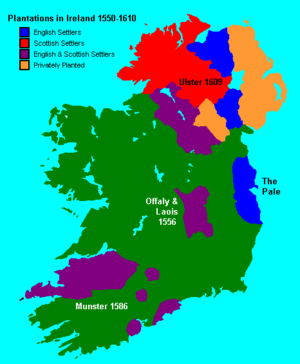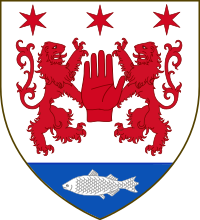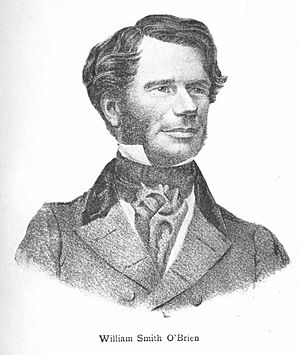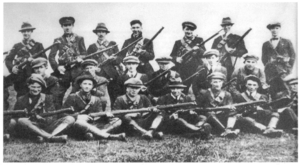Irish republicanism facts for kids
Irish republicanism (Irish: poblachtánachas Éireannach) is a political idea. It's about creating an independent Irish republic. This means Ireland would be completely free from any British rule.
Contents
History of Irish Republicanism
Early British Rule in Ireland
After the Norman invasion of Ireland in the 1100s, parts of Ireland were ruled by England. Some native Irish people, called Gaels, tried to fight back. But they didn't have one single goal.
In the 1500s, England took more control of Ireland. This included the Plantations of Ireland. Lands belonging to Irish families and Norman families were taken. They were given to Protestant settlers from England and Scotland. The Plantation of Ulster started in 1609. Many English and Scottish settlers moved to the province of Ulster.
Before the idea of Irish republicanism, there were fights against English presence. In the late 1500s, Hugh O'Neill led a resistance. This was called the Nine Years' War. The Irish leaders were defeated and left Ireland. This event is known as the 'Flight of the Earls'.
Early Ideas for an Irish Republic
In the 1600s, most countries in Europe were ruled by kings and queens. Republics were rare. But in 1627, a document first suggested an independent Irish republic. This idea came from Irish Catholic Gaels living in other countries. They had help from Habsburg Spain.
These Irish exiles had joined the Spanish army. They had left Ireland after the Flight of the Earls. They wanted to invade Ireland and set up an Irish government. This government would be loosely connected to the Habsburg Empire.
There were disagreements among the Irish leaders in Spain. They argued over who should lead the new Irish government. To solve this, Spanish ministers suggested a "Kingdom and Republic of Ireland" in 1627. They said the leaders would be "Captains General of the said Republic." But these plans never happened.
Ten years later, the Irish Rebellion of 1641 began. This was a fight against English rulers. It included both Irish Gaels and the Old English. They wanted to restore lost lands and protect Catholic rights. The Catholic leaders formed the Catholic Confederation. This group acted as the government of Ireland for a short time. But in 1649, English forces took over Ireland. The Catholic landowners lost their lands forever.
United Irishmen and the 1798 Rebellion
The start of modern Irish republicanism came from the Society of United Irishmen. This group was formed in 1791. They were inspired by thinkers like John Locke and Thomas Paine. At first, they wanted changes to parliament and rights for Catholics. But when these changes didn't happen, they decided to fight for revolution.
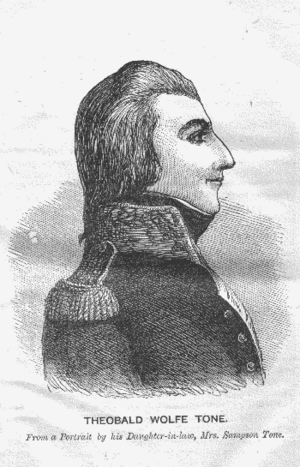
The movement was mainly led by liberal Protestants. Many were Presbyterians from Ulster. Key founders included Wolfe Tone, Thomas Russell, and James Napper Tandy. By 1797, the United Irishmen had about 100,000 members. They included Catholics, Presbyterians, and even Anglicans.
The Irish Rebellion of 1798 started on May 23. French soldiers landed in Killala on August 22 to help the rebels. The rebels had some success in County Wexford. But British forces eventually defeated them. Many leaders were arrested and executed.

Acts of Union and Robert Emmet
Even after the 1798 rebellion was put down, some small groups continued to fight. They used guerrilla tactics in the Wicklow Mountains. Leaders like Michael Dwyer attacked British forces.

The British government feared more uprisings. They worried rebels would get help from France again. This led to the Acts of Union 1800. The Irish Parliament voted to join with Great Britain. This created the United Kingdom of Great Britain and Ireland. British leaders used bribery to get this vote passed. They also promised rights for Catholics, but this promise was not kept.
In 1803, Robert Emmet tried to form an independent Irish republic. Emmet was also a member of the United Irishmen. He planned to take Dublin Castle by force. His group made weapons and explosives in Dublin.

Emmet wrote a statement of independence. It said their goal was "to establish a free and independent republic in Ireland." It also said they would fight against "English dominion."
However, Emmet's forces were much smaller than planned. The rebellion began in Dublin on July 23. They could not take Dublin Castle. The uprising turned into riots. Emmet escaped but was captured on August 25. He was hanged on September 20, 1803. This effectively ended the Society of United Irishmen.
Young Ireland and the Fenians
The Young Ireland movement started in the late 1830s. They wanted to end British rule in Ireland. They also wanted to bring back the Irish Parliament in Dublin. They encouraged studying Irish history and the Irish language. Important Young Irelanders included Charles Gavan Duffy and Thomas Davis.
The Young Irelanders eventually left the Repeal Association. Their leader, Daniel O'Connell, did not support using force. The Young Ireland movement ended with a failed uprising in 1848. This was influenced by the French Revolution of 1848. It was also made worse by the government's slow response to the Great Famine. After the uprising, several leaders were arrested and sent to Van Diemen's Land.
The Fenian movement came next. It included the Fenian Brotherhood and the Irish Republican Brotherhood (IRB). These groups were formed in the United States and Ireland. Their goal was to create an independent Irish republic.
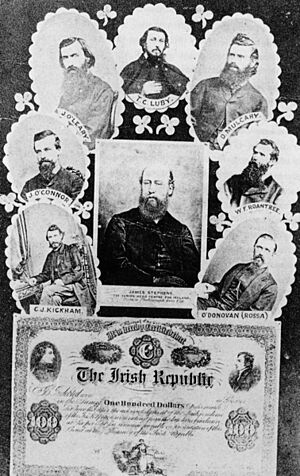
The IRB was founded on Saint Patrick's Day in 1858 in Dublin. Its oath stated the goal was to make "Ireland an independent Democratic Republic." The Fenian Brotherhood was formed in the US. Its main job was to send weapons and money to the IRB in Ireland. The name "Fenian" came from ancient Irish warriors called the Fianna.
Public support for the Fenians grew in Ireland. They organized large funerals for republican figures. This helped them gain popularity. However, some saw the movement as violent. The Fenian Brotherhood in America split into two groups. One group wanted to focus on invading British Canada. The other wanted to plan an uprising in Ireland. The attacks in Canada are known as the "Fenian raids." It was during these battles that the name "Irish Republican Army" was first used.
Twentieth Century and Independence
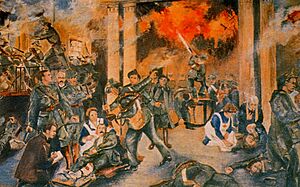
After Ireland joined Britain in 1801, Irish independence movements were put down. Rebellions in 1803, 1848, and the 1860s were met with harsh responses from British forces.
In 1916, the Irish Republican Brotherhood organized the Easter Rising in Dublin. They declared an Irish Republic. The Rising was put down after six days. Most of its leaders were executed by the British. This was a major turning point in Irish history. It led to the Irish War of Independence and the end of British rule in most of Ireland.
From 1919 to 1921, the Irish Republican Army (IRA) fought as a guerrilla army. They fought against the British. The British government created a police force called the "Black and Tans." Both sides used tough tactics. Republicans also set up their own courts. This showed they had public support.
In August 1920, Irish Republican prisoners went on a hunger strike. They wanted to be released and treated as political prisoners. Three men died, including the Lord Mayor of Cork, Terence MacSwiney. The Black and Tans carried out violent acts. These included the Bloody Sunday massacre in November 1920. They also burned half the city of Cork in December. These actions, along with strong support for republican ideas, led to widespread backing for the Irish rebels.
In 1921, the British government and Irish republican leaders signed the Anglo-Irish Treaty. This ended the conflict.
Irish Free State and Republic of Ireland
Many people were unhappy with the Anglo-Irish Treaty. The IRA had fought for a fully independent republic for all of Ireland. The treaty meant Ireland would be a dominion under the British crown. It also meant Ireland would be divided. But some republicans felt it was the best they could get.
The Irish parliament, Dáil Éireann, voted to approve the treaty. Éamon de Valera, who had been President of the Irish Republic, refused to accept the decision. He led those who opposed the treaty out of the Dáil. The pro-Treaty republicans formed the Cumann na nGaedheal party. The anti-Treaty republicans kept the Sinn Féin name. The IRA also split into pro-Treaty and anti-Treaty groups. The pro-Treaty group became the new Irish National Army.
This led to the Irish Civil War. Michael Collins became Commander-in-Chief of the National Army. The war ended in May 1923. But the harsh actions on both sides left a lasting impact on Irish politics. In October 1923, Irish republican prisoners went on mass hunger strikes. They protested being held without trial by the new Irish Free State.
De Valera later changed his mind. He decided to work within the Free State's political system. In 1926, he formed a new party called Fianna Fáil. In 1931, Ireland became a sovereign state. The next year, De Valera became leader. He slowly began to change the country from a constitutional monarchy to a constitutional republic.
In 1937, the Constitution of Ireland was written. It changed the state's name to Éire (Ireland). It also said that the national territory was the whole of Ireland. The new state had a President of Ireland elected by the people. It removed all mention of the monarchy. De Valera called it a republic. But it stayed in the British Commonwealth.
In 1948, John A. Costello's government declared Ireland a republic. This led the British government to pass the Ireland Act 1949. This act stated that Northern Ireland would remain part of the United Kingdom. Ireland also left the Commonwealth. After this, the republican movement decided to focus on Northern Ireland.
Republicanism in Northern Ireland
Northern Ireland's Beginnings (1921–1966)
In 1921, Ireland was divided. Most of the country became the independent Irish Free State. But six of Ulster's nine counties stayed part of the United Kingdom. This area became Northern Ireland. From 1920 to 1922, there was much violence between unionists (who wanted to stay with Britain) and nationalists (who wanted a united Ireland).
Northern Ireland had its own government. The Ulster Unionist Party (UUP) controlled it for 50 years. Voting often happened along religious lines. This meant the government rarely changed. In local areas, voting boundaries were drawn to weaken nationalist communities.
The Nationalist population in Northern Ireland was mostly Catholic. They often felt left out politically and economically. They had fewer job chances and lived in separate areas. Many Catholics felt the Unionist government was unfair and favored Protestants.
In the 1930s, the IRA carried out small attacks in Northern Ireland. During World War II, the IRA hoped for German support. Suspected republicans were held in prison on both sides of the border. The Border Campaign in the mid-1950s was a failure.
Civil Rights and New Divisions (1966–1969)
In the late 1960s, Irish activists saw similarities between their struggle and the civil rights campaign in the US. Student leaders like Bernadette Devlin McAliskey used peaceful protests. Republicans, who were mostly not fighting at the time, joined the civil rights campaign.
As a response, loyalist groups started to appear. The Ulster Volunteer Force (UVF) was one of the first. They aimed to stop any efforts to reunite Northern Ireland with the Republic of Ireland.
By mid-1969, violence in Northern Ireland grew. The IRA chose not to get involved at first. In late August, the British government sent troops to stop the violence. Some Catholics first welcomed the British Army. But later events, like Bloody Sunday, turned many against them.
The Troubles and Hunger Strikes (1970–1985)
The Republican movement split in 1970. This was between those who wanted a political approach and those who wanted to keep fighting. The leader of the IRA, Cathal Goulding, believed the IRA couldn't win with military tactics. He wanted the IRA to become a revolutionary movement. This would overthrow both governments and create a socialist republic.
This led to a split. The Official IRA supported Goulding's ideas. The Provisional IRA (Provos) were traditional nationalist republicans. The Provos immediately began a large campaign against British forces and targets in Northern Ireland. The Official IRA also fought at first. But in 1972, the Official IRA declared a ceasefire. Today, "Irish Republican Army" usually means the Provisional IRA.
The conflict continued through the 1970s and 1980s. Thousands of lives were lost. Loyalist groups attacked targets in the Republic of Ireland. The IRA attacked targets in England. In the 1980s, Provisional Sinn Féin, the political part of the Provisional IRA, started taking part in elections.
In 1976, the British government stopped treating convicted paramilitary prisoners as political prisoners. Republican prisoners began protests. This led to a hunger strike in 1981. Ten hunger strikers died, including Bobby Sands. This drew worldwide attention.
Peace Process and Beyond (Since 1986)
In the late 1980s, the British Government became more willing to make agreements with Irish Nationalists. However, violent republican actions continued. This made it harder for Unionists and Britain to work with violent republicans.
This changed in 1992–93. Talks between John Hume and Gerry Adams led to Sinn Féin agreeing to peaceful methods.

In 1994, leaders of the main nationalist parties, Gerry Adams and John Hume, began peace talks. They talked with Unionist leaders and the British government. Most paramilitary groups, including the IRA and UVF, had representatives. In 1998, the IRA supported the Good Friday Agreement. This agreement was between nationalist and unionist parties and both governments. Another small group split from the IRA to form the Real IRA (RIRA).
Since 1998, the IRA and UVF have kept a ceasefire.
Today, the republican movement has two main parts. Moderates want to reunite Ireland peacefully. Dissident republicans want to continue armed action. In July 2005, the IRA announced that their armed conflict was over. They said their weapons would be put out of use.
What Irish Republicanism Believes
Irish republicanism includes many different ideas. It has involved "militant nationalists, romantic Fenians, Catholic groups, Marxists, socialists, and liberal Protestants." Common ideas include national self-determination and Irish identity.
Rejecting British Rule
Irish republicans see British rule in any part of Ireland as wrong. They believe it is a foreign government. Some also reject the Republic of Ireland. This is because they believe it accepts the division of Ireland and British rule in Northern Ireland.
Republicans reject all parts of the British state. This includes the British parliament, police, and court systems. This has led republicans to create their own alternative systems. However, some Irish Republican political parties have taken part in Northern Irish local elections since the 1970s.
Political Parties Today
Active Republican Parties
Here are some active republican parties in Ireland:
- Sinn Féin is a republican party in Ireland. During the Northern Ireland troubles, it was closely linked to the Provisional Irish Republican Army. It supported their armed campaign. Its policies combine Irish nationalism with socialist ideas on money and society. Mary Lou McDonald leads the party. It works in both the Republic of Ireland and Northern Ireland. Sinn Féin members do not take their seats in the British parliament. They refuse to accept that body's right to rule in Ireland.
- Fianna Fáil was founded as a republican party. It came from Sinn Féin. But it decided to take part in constitutional politics in Ireland. The party still calls itself "The Republican Party."
- Éirígí is a socialist republican political party. It was formed in Dublin in 2006. It started as a campaigns group. It became a full political party in 2007. It is described as a small group based on revolutionary socialist ideas.
- Saoradh is a socialist republican party created in 2016. It is linked to dissident Republicans. It is also said to have ties to the New IRA.
- Republican Sinn Féin was formed in 1986. Its members do not take seats in the assemblies of the Republic of Ireland or Northern Ireland. They do not see these governments as legitimate. It is linked to the Continuity IRA. Their goals are to end British rule in Northern Ireland and unite the island.
- Irish Republican Socialist Party (IRSP) was founded in 1974. It was started by former Official IRA member Seamus Costello. The party quickly formed a military group called the Irish National Liberation Army (INLA). The INLA has recently given up its weapons.
- Aontú split from Sinn Féin in 2019. As of 2020, Aontú has one member in the Dáil, Peadar Tóibín. They also have five local councillors.
- Republican Network for Unity was formed in 2007. They opposed Sinn Féin's vote to support the Police Service of Northern Ireland. This group is seen by some as the political part of Óglaigh na hÉireann. This is a militant dissident republican group.
- Anti-Imperialist Action Ireland (AIA) is a socialist republican group. It was founded in 2017. The group opposes the Good Friday Agreement and does not take part in elections.
See also
 In Spanish: Republicanismo irlandés para niños
In Spanish: Republicanismo irlandés para niños


